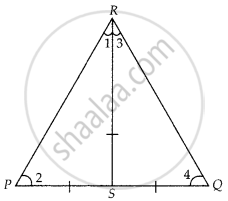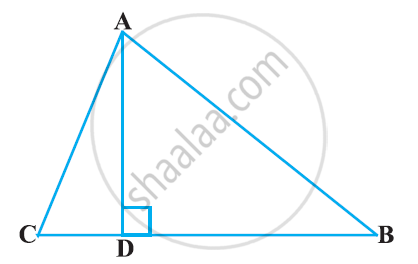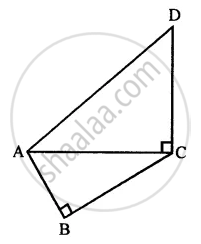Advertisements
Advertisements
Question
If S is a point on side PQ of a ΔPQR such that PS = QS = RS, then ______.
Options
PR . QR = RS2
QS2 + RS2 = QR2
PR2 + QR2 = PQ2
PS2 + RS2 = PR2
Solution
If S is a point on side PQ of a ΔPQR such that PS = QS = RS, then PR2 + QR2 = PQ2.
Explanation:

Given, in ∆PQR,
PS = QS = RS ...(i)
In ∆PSR,
PS = RS ...[From equation (i)]
⇒ ∠1 = ∠2 ...(ii) [Angles opposite to equal sides are equal]
Similarly, in ∆RSQ,
RS = SQ
⇒ ∠3 = ∠4 ...(iii) [Angles opposite to equal sides are equal]
Now, in ∆PQR,
Sum of angles = 180°
⇒ ∠P + ∠Q + ∠P = 180°
⇒ ∠2 + ∠4 + ∠1 + ∠3 = 180°
⇒ ∠1 + ∠3 + ∠1 + ∠3 = 180°
⇒ 2(∠1 + ∠3) = 180°
⇒ ∠1 + ∠3 = `180^circ/2` = 90°
∴ ∠R = 90°
In ∆PQR, by Pythagoras theorem,
PR2 + QR2 = PQ2
APPEARS IN
RELATED QUESTIONS
The perpendicular from A on side BC of a Δ ABC intersects BC at D such that DB = 3CD . Prove that 2AB2 = 2AC2 + BC2.

In the figure, given below, AD ⊥ BC.
Prove that: c2 = a2 + b2 - 2ax.
M andN are the mid-points of the sides QR and PQ respectively of a PQR, right-angled at Q.
Prove that:
(i) PM2 + RN2 = 5 MN2
(ii) 4 PM2 = 4 PQ2 + QR2
(iii) 4 RN2 = PQ2 + 4 QR2(iv) 4 (PM2 + RN2) = 5 PR2
Find the side of the square whose diagonal is `16sqrt(2)` cm.
In the given figure, AD = 13 cm, BC = 12 cm, AB = 3 cm and angle ACD = angle ABC = 90°. Find the length of DC.

In the right-angled ∆LMN, ∠M = 90°. If l(LM) = 12 cm and l(LN) = 20 cm, find the length of seg MN.
In triangle ABC, line I, is a perpendicular bisector of BC.
If BC = 12 cm, SM = 8 cm, find CS
In a right angled triangle, if length of hypotenuse is 25 cm and height is 7 cm, then what is the length of its base?
The perimeter of the rectangle whose length is 60 cm and a diagonal is 61 cm is ______.
The longest side of a right angled triangle is called its ______.
